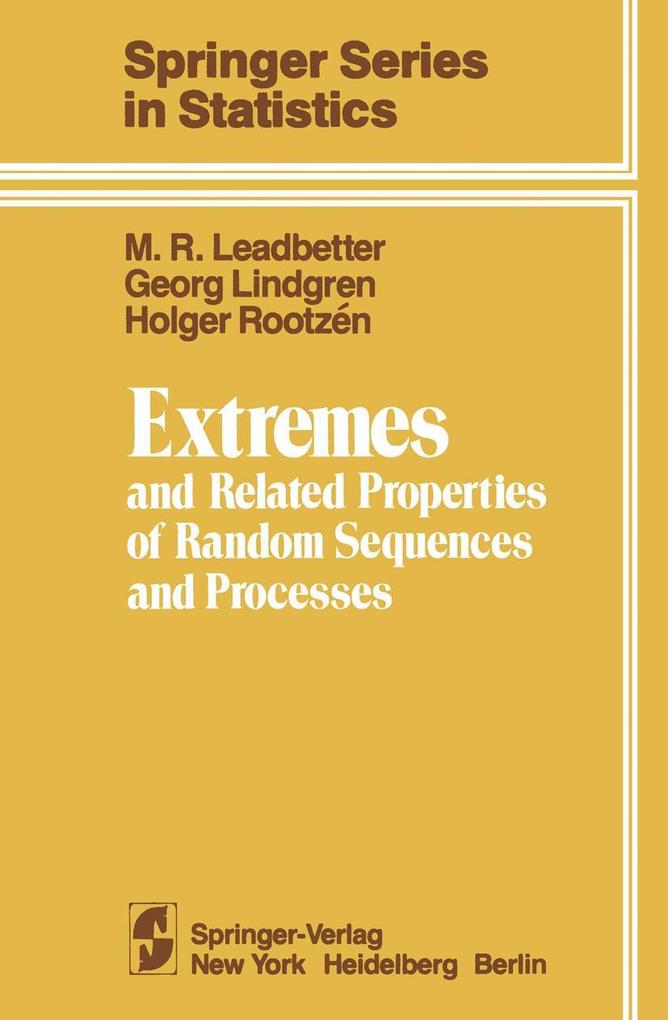
Zustellung: Di, 24.06. - Do, 26.06.
Versand in 2 Tagen
VersandkostenfreiBestellen & in Filiale abholen:
Classical Extreme Value Theory-the asymptotic distributional theory for maxima of independent, identically distributed random variables-may be regarded as roughly half a century old, even though its roots reach further back into mathematical antiquity. During this period of time it has found significant application-exemplified best perhaps by the book Statistics of Extremes by E. J. Gumbel-as well as a rather complete theoretical development. More recently, beginning with the work of G. S. Watson, S. M. Berman, R. M. Loynes, and H. Cramer, there has been a developing interest in the extension of the theory to include, first, dependent sequences and then continuous parameter stationary processes. The early activity proceeded in two directions-the extension of general theory to certain dependent sequences (e. g. , Watson and Loynes), and the beginning of a detailed theory for stationary sequences (Berman) and continuous parameter processes (Cramer) in the normal case. In recent years both lines of development have been actively pursued.
Inhaltsverzeichnis
I Classical Theory of Extremes. - 1 Asymptotic Distributions of Extremes. - 2 Exceedances of Levels and kth Largest Maxima. - 2. 1. Part II Extremal Properties of Dependent Sequences. - 3 Maxima of Stationary Sequences. - 4 Normal Sequences. - 5 Convergence of the Point Process of Exceedances, and the Distribution of kth Largest Maxima. - 6 Nonstationary, and Strongly Dependent Normal Sequences. - 6. 1. Part III Extreme Values in Continuous Time. - 7 Basic Properties of Extremes and Level Crossings. - 8 Maxima of Mean Square Differentiable Normal Processes. - 9 Point Processes of Upcrossings and Local Maxima. - 10 Sample Path Properties at Upcrossings. - 11 Maxima and Minima and Extremal Theory for Dependent Processes. - 12 Maxima and Crossings of Nondifferentiable Normal Processes. - 13 Extremes of Continuous Parameter Stationary Processes. - Applications of Extreme Value Theory. - 14 Extreme Value Theory and Strength of Materials. - 15 Application of Extremes and Crossings Under Dependence. - Appendix Some Basic Concepts of Point Process Theory. - List of Special Symbols.
Produktdetails
Erscheinungsdatum
10. November 2011
Sprache
englisch
Auflage
Softcover reprint of the original 1st edition 1983
Seitenanzahl
352
Reihe
Springer Series in Statistics
Autor/Autorin
M. R. Leadbetter, G. Lindgren, H. Rootzen
Verlag/Hersteller
Produktart
kartoniert
Gewicht
534 g
Größe (L/B/H)
235/155/20 mm
ISBN
9781461254515
Entdecken Sie mehr
Bewertungen
0 Bewertungen
Es wurden noch keine Bewertungen abgegeben. Schreiben Sie die erste Bewertung zu "Extremes and Related Properties of Random Sequences and Processes" und helfen Sie damit anderen bei der Kaufentscheidung.










